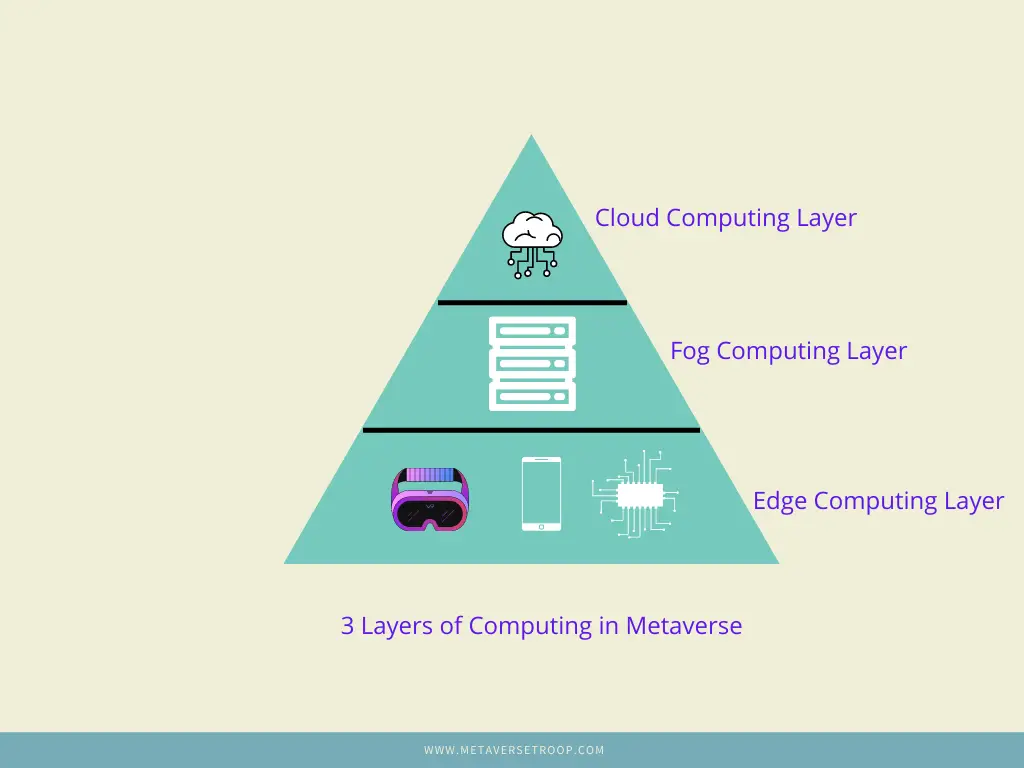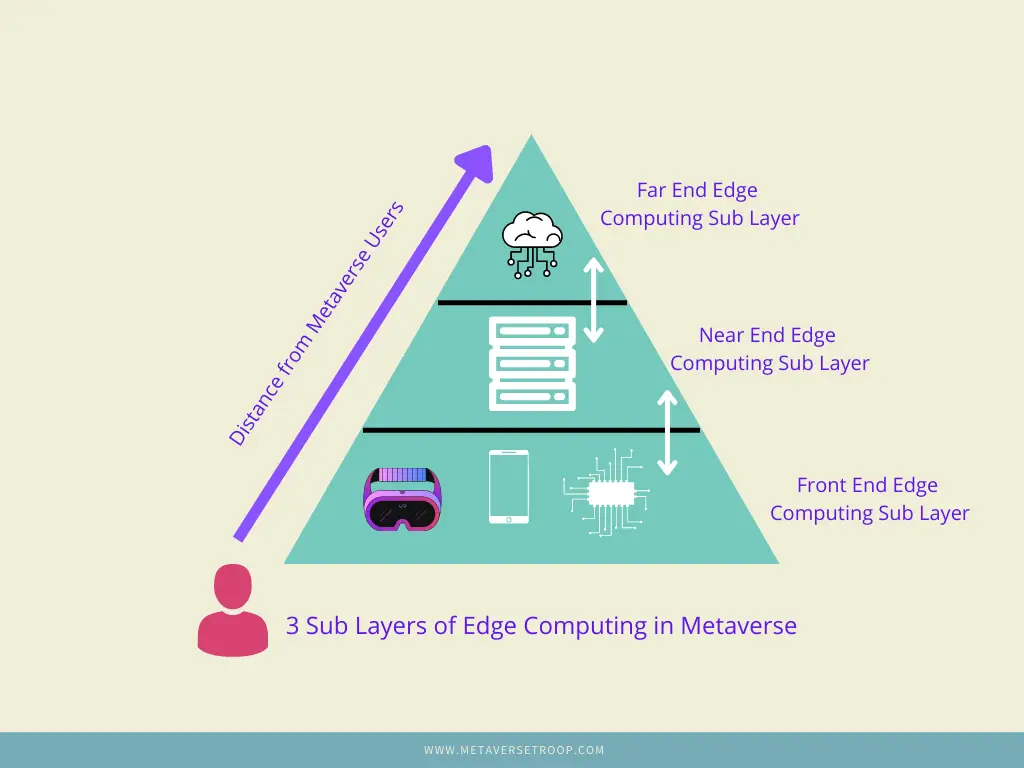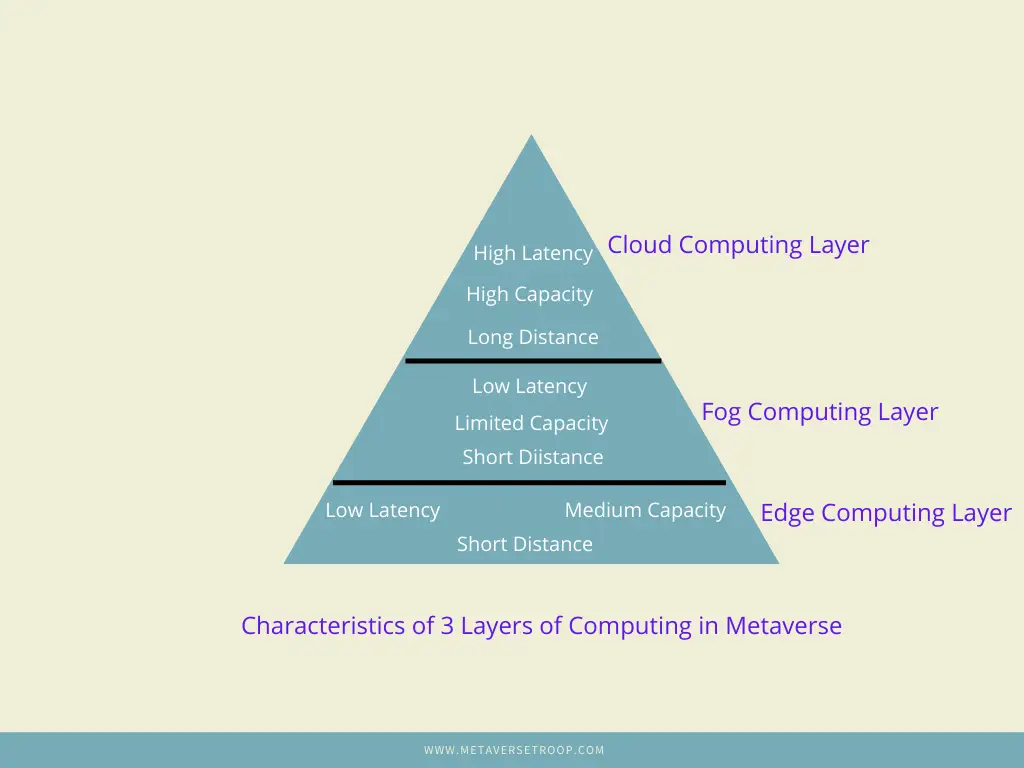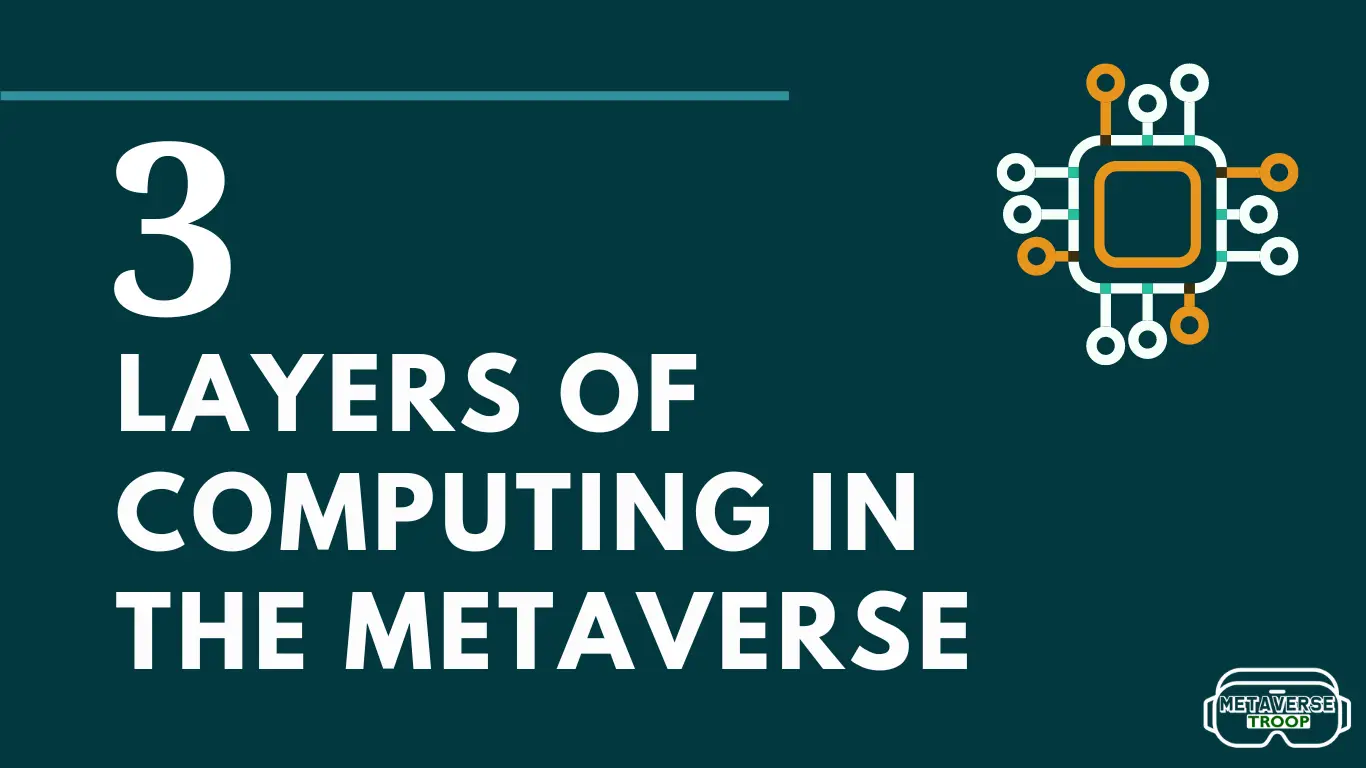Layers of Computing in the Metaverse | Cloud Computing Layer of Metaverse | Fog Computing Layer of Metaverse | Edge Computing Layer of Metaverse
As already discussed in the last post-computation in metaverse, metaverse requires huge computing power to provide users an immersive 3D virtual world. A single device or platform cannot sustain the metaverse. So, we require 3 layers of computing in the metaverse.
This blog post is a continuation of my last blog post on computation of metaverse. In here I have explained in detail all the 3 layers of computing in the metaverse – cloud, fog and edge. Cloud gaming and Microsoft flight simulator are also explained in cloud computing. 3 sublayers of Edge computing-far, ear and front layers of computation in metaverse are also discussed.
3 LAYERS OF COMPUTING IN THE METAVERSE
A single layer infrastructure cannot handle huge computation needs in the metaverse. Rendering of images and videos is a core component of metaverse. So, 3 layers of computing in the metaverse is proposed as shown in the figure below. The layers are listed below.
- Cloud Computing Layer
- Fog Computing Layer
- Edge Computing Layer

CLOUD COMPUTING LAYER
The first and the top most layers of computing in the metaverse is cloud computing as shown in the figure in the above section. In this section, I will explain cloud computing for metaverse in respect of In simple words, cloud computing is a system/architecture where computing power needed is made as an online service.
The best example of application of cloud computing is Google Drive, iCloud, Amazon Web Services (AWS), etc. Here the cloud stores your files and you can do a host of tasks with these files through your mobile and computer.
In cloud computing your physical devices need to transfer the data on to the cloud. But the computation power is provided by the cloud servers to do the tasks. This is where edge computing and fog computing come to play.
CLOUD COMPUTING LAYER FOR METAVERSE
The metaverse is resource and computing hungry. It needs a huge amount of computation power, storage space and fast and advanced communication technology. Moreover, with the increase of user base cloud computing is must and essential for any metaverse application. Cloud gaming is one the use case of cloud computing for metaverse as discussed below.
CLOUD GAMING IN METAVERSE
Game is one of the most sought out and prevalent use of metaverse beside other use cases of metaverse. All the metaverse games are hosted in the cloud and that is why it is called cloud gaming. It uses cloud layer of computing in the metaverse.
Cloud gaming integrates cloud computing to enable high quality immersive games in metaverse. In the case of mobile devices, mobile cloud computing is used. It provides computing services to either mobile mobiles or mobile embedded systems. One of the best examples of cloud gaming is Microsoft Flight Simulator which is explained briefly in the next section below.
In mobile cloud computing, the cloud providers install the servers in private infrastructure and the services of the cloud are provided to the client via virtual machines. But the most economical approach is to combine cloud and in-house resources for providing services in metaverse.
Users’ devices like mobile, PCs, tablets, etc. are usually unable to store and process games of metaverse. Therefore, most of the data and processing power is done in the cloud and the gameplay content is streamed on users devices. The user’s device only stores a core amount of data with minimal computation.
Microsoft Flight Simulator
Microsoft Flight Simulator provides the users with realistic flying experience. There are 2 trillion rendered trees and plants, 1.5 billion buildings and almost all roads and infrastructure and airports of international cities. You can say that it has a digital twin of airports, roads, building, etc.
But for providing this immersive experience Microsoft Flight Simulator comes with a cost. It requires 2.5 petabytes of data to run. Generally, any user’s PC, Laptop, etc is unable to store and process such a tremendous amount of data. So, it has combined cloud computing architecture and in-house resources to run the simulations.
The data and processing power is done in the cloud layer of computing in the metaverse. and the simulation content like birds eye view of cities is streamed on users device. The user’s device only stores a core amount of data with computations offloaded whenever necessary
FOG COMPUTING FOR METAVERSE
Fog computing is the 2nd layers of computing in the metaverse. It is sandwiched between the cloud computing layer of metaverse and edge computing layer of metaverse. In layman’s world the work of fog computing for metaverse is to lessen or minimize the burden of cloud computing.
Data is transferred from edge devices to the cloud computing layer. If unnecessary data is transferred anytime, it will burden the cloud computing layer. Here fog computing layers come to play to lessen the burden of cloud layer.
Fog layer of computing in the metaverse receives data from the edge computing layer at first. It then decides what data is relevant and what is not using Artificial Intelligence (AI). Then the relevant data is send to the cloud computing layer and the reset is discarded/deleted.
FOG COMPUTING FOR METAVERSE
Metaverse has a lot of connected edge devices like AR/VR headset, IoT devices, sensors, etc. A lot of communication, interaction, transfer of data takes place every seconds/microseconds from the edge layer devices The data sent to the metaverse may be sensitive, essential, relevant, etc. or might not be.
If all of the data is sent from the edge layer, then it will put a lot of burden on the cloud layer. Moreover, mobile cloud computing for metaverse can no longer support the high demands for real time applications like AR/VR. These devices need near to zero latency.
To reduce transmission delay or latency, fog layer of computing in the metaverse. is installed between the cloud computing layer for metaverse and edge computing layer for metaverse. It deploys many fog nodes in this layer.
For example, fog computing nodes may be installed on speeding vehicles, trains or in low network area, etc. In this situation, users might be unable to access the metaverse as they cannot maintain a stable connection with the cloud.
To reduce latency, Fog nodes can connect the edge devices or users through wireless connection such as Wi-Fi and Bluetooth and provide storage service and computation in metaverse. Moreover, privacy in metaverse is mitigated by keeping users personal information within the fog node and sending encrypted data to the cloud.
So, from the above discussion it is obvious that fog computing is a an important layers of computing in the metaverse.
EDGE COMPUTING
Edge computing is computing that is done at or near or edge of the source of the data being generated. Ege computing basically connects edge devices such input devices, sensors, IoT devices, etc. It is the most essential layer among the 3 layers of computing in the metaverse.
Data generated by these edge devices are sent to the cloud computing layer generally through fog layer. Traffic of data from these edge devices can be massive and inefficient. Additional irrelevant data is sent to the cloud that is scraped away by the fog computing layer as discussed in the previous section.
Edge computing can be split into 3 layers based on location of cloud server and user. They are listed below.
- Far End Edge Computing
- Near End Edge Computing
- Front End Edge Computing

FAR END
In the far end scenario, the edge devices/users are located farthest from the cloud server. Therefore, transmission latency in this type of scenario is substantial. The type of computing in this type of situation is known as far end computing.
In this layer of computing in the metaverse, cloud servers provide additional computational power and data storage. It can perform parallel data processing and machine learning.
NEAR END
Near end edge computing layer lies between the cloud computing layer and far end edge computing layer. Majority of traffic flows are handled by this layer. Majority of data computation and storage are transferred to this layer.
Real time data processing, data caching and computational offloading are the essential resource requirements in edge computing. This layer of computing in the metaverse handles all of this.
FRONT END
Front end of the edge computing layer is the place where edge devices such as sensors, IoT devices, etc are located. Large number of local edge devices in this layer delivers real-time services for some applications.
For the users, front end edge computing provides more engagement and response.But there is limitation to edge devices in this layer due to their limited computational power. They have to forward the data to cloud layer.
EDGE COMPUTING FOR METAVERSE
Metaverse requires as much computational capacity as possible. The users accessing metaverse through their mobile phones requires latency to be as low as possible . Low latency is required in metaverse to real-time, advanced, computation-intense capabilities like speech recognition and AR/VR.
Edge computing is one of the solutions to overcome the needs for metaverse. It provides
- Low latency
- High efficiency
- Security
to sustain the metaverse. So, it is an important layer of computation in the metaverse.
Edge devices of metaverse like AR/VR headset, Haptic suits, sensors, etc transmits data to the cloud computing layer. The data passes through the fog computing layer before reaching the cloud layer.
Most of the computing is done at this layer and fog layer to reduce the burden of cloud layer. This layer has the lowest latency among all the 3 layers of computing in the metaverse.
CHARACTERTICS OF 3 LAYERS OF COMPUTING IN METAVERSE
The figure below lists the characteristics of all the 3 layers of computing in metaverse.

CONCLUSION
This blog post presented you with a detailed discussion on 3 layers of computing in the metaverse. I have discussed the cloud computing layer, Fog computing layer and Edge computing layer. The sub layer of edge computing layer i.e far end, near end and front end computing layer of metaverse.
